Radial Nerve Palsy PT – ECRB Transfer
Radial nerve palsy results in inability to extend the wrist, fingers and thumb. If radial nerve repair and regeneration is not feasible tendon transfers can restore some of the lost function. One of the standard tendon transfers that can restore wrist extension is the pronator trees (median nerve inervation) to extensor carpi radials brevis (radial nerve inervation). These two muscles work synergistically i.e. wrist pronation will provide wrist extension. In addition, to provide finger extension the flexor carpi ulnaris (ulnar nerve inervation) to the extensor digitorum com minus (radial nerve inervation). Absent thumb extension can be restored with a palmaris longus (median nerve inervation) to extensor pollicis longus (Radial nerve inervation). These photographs demonstrates the PT to ECRB transfer.
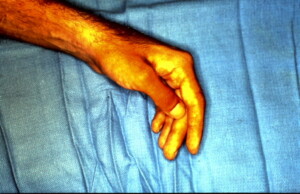 Pre-operative hand with wrist drop, lack of finger and thumb extension.
Pre-operative hand with wrist drop, lack of finger and thumb extension.
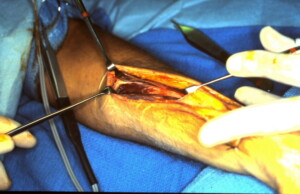 The pronator teres is isolated on the volar surface of the forearm.
The pronator teres is isolated on the volar surface of the forearm.
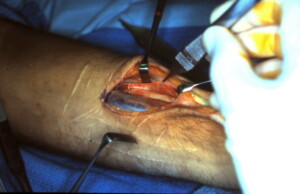 The insertion of the pronator teres is taken off the radius with a periosteal extension to provide greater length to fascilitate the tenorrhaphy with the extensor carpi radialis brevis.
The insertion of the pronator teres is taken off the radius with a periosteal extension to provide greater length to fascilitate the tenorrhaphy with the extensor carpi radialis brevis.
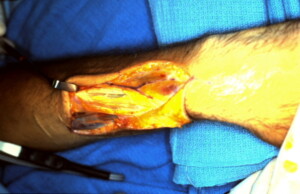 The extensor carpi radialis brevis is identified so the tenorrhaphy can be completed. An end to side juncture is desired in case some return of native radial nerve function occurs or if this is used as an internal splint during radial nerve regeneration after repair.
The extensor carpi radialis brevis is identified so the tenorrhaphy can be completed. An end to side juncture is desired in case some return of native radial nerve function occurs or if this is used as an internal splint during radial nerve regeneration after repair.
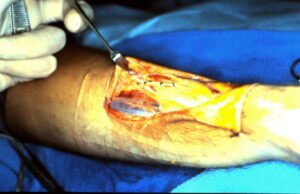 The pronator teres is passed over the brachioradialis subcutaneously and the tenorrhaphy is performed with adequate tension to maintain mild wrist extension.
The pronator teres is passed over the brachioradialis subcutaneously and the tenorrhaphy is performed with adequate tension to maintain mild wrist extension.



